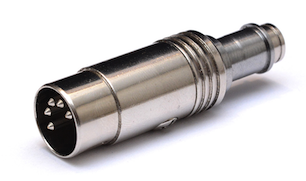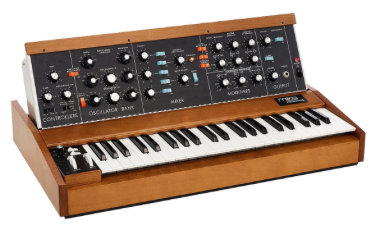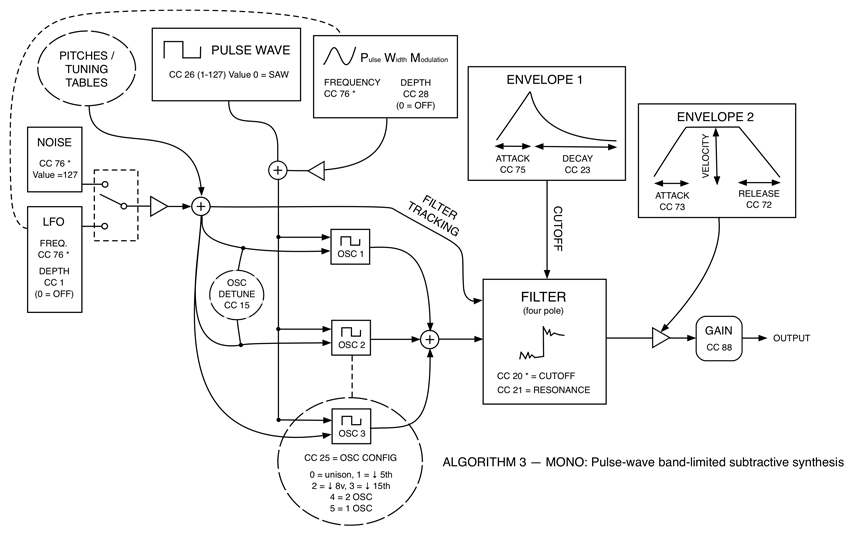



November 26, 2020

We're pleased to announce our FLASH synth firmware update v6 — including an exciting new pulse-wave band-limited subtractive synthesis algorithm from mitxela, intended to emulate the sound of the famous 1970's minimoog synthesizer. From our new documentation:

The monophonic version of our algorithm (CC24 = 9) brings out the full potential of our synth, and is much more involved than any of the previous algorithms, combining three oscillators with a pitch-tracking four pole resonant filter to make an efficient monophonic subtractive synth, with filter cutoff that can be altered smoothly in realtime. This algorithm is meant to loosely approximate the original minimoog synthesizer. The currently limited number of oscillator configurations (CC25) are based on diagrams in the original minimoog patch book. More variations may be added in future firmware updates.

The monophonic synth CCs share some core things in common with the first two algorithms so that switching between algorithms on the fly remains fairly intuitive, though there are some important differences to keep in mind, as follows. The FM frequency knobs now control Filter Cutoff (CC20) and Filter Resonance (CC21). Note that if Filter Cutoff is set to zero, no sound will be heard. Envelope 2 controls remain the same, with Envelope 1 now applying to the Filter, but without the Depth parameter, since this is handled by Cutoff and Resonance. For a sustained sound, set the Decay parameter of Envelope 1 at or near to zero. Higher values will result in more quickly decaying increasingly percussive sounds. The Wave Parameter (CC26) controls the “Duty Cycle” (pulse width) of the waveform, or switches it to sawtooth with a value of 0. “Detune” alters the first two oscillators (for details, see under the heading Detune above). Since this is not a wavetable algorithm, the selection of waveforms used in algorithms 1 and 2 are not available. Instead, “Waveform Select” (CC25) becomes “OSC Config” and controls the behaviour of our three oscillators. Values 0 through 3 apply to the third oscillator only, changing its behaviour as follows: 0 = unison, 1 = down a 5th, 2 = down an octave, and 3 = down two octaves from the other two oscillators. Values 4 and 5 optionally turn off 1 or 2 of the oscillators for a leaner sound: 4 = third oscillator off, 5 = oscillators 2 and 3 both off. Arpeggiator, LFO rate, and portamento behave as expected; however, a significant difference to the other algorithms is that the LFO rate applies to not just one but two kinds of modulation, normal LFO and Pulse Width Modulation (PWM). The latter gives a sweeping or flanging effect, as it changes the duty cycle according to the LFO frequency. For the uninitiated, using PWM and Modulation together can be a bit tricky at first, with results that can be quite subtle. We recommend first setting the PWM control to zero, then adjusting the Modulation control. Conversely, to try out PWM, first set the Modulation control to zero. Once you get used to controlling each independently, mixing them will be easier.
Just for fun (by no means a full demo), I play a line and twist a couple of knobs (namely, Filter- Cuttoff and Resonance). Couldn't resist maxing out the LFO frequency at the end. I honestly didn't try to optimise this patch, just pulled up the algorithm, set a PWM and winged it. Points if you recognise the riff! …
There is also a 16-voice polyphonic version of the algorithm, albeit without any filtering, but still with envelope controls and LFO, which gives you clean pulse waves across the entire range. This time around, the development time went to the MONO version of the algorithm. We'll expand on the POLY version in a future firmware update, and maybe add other variations.

In all this update gives FLASH users ten basic synth configurations to choose from. Does it stop there? Of course not. FLASH has been designed from the ground up to be expandable. New algorithms can be added in future updates.
As with the existing algorithms, everything is totally retuneable, both in real time using multi-channel pitch bend, or using any of the 16 user-programmable tuning tables stored in the synth's memory. For a little guy running on MIDI power, this synth sure delivers! I for one think mitxela did a really fantastic job on this new algorithm.
The release of this new algorithm coincides with our fourth run of synths starting at midnight tonight (November 27th), and all new synths will of course come with the latest firmware installed. Current owners of previously purchased FLASH units will need to install the latest version of UTE (1.8.3) and update the synth's firmware to v6 via the UART programmer to start using the new algorithm.
The UTE update can be downloaded from its product page.
Stay well everyone,
Aaron
[ Showing 1 entry | Previous entry | Next entry | Show all entries ]